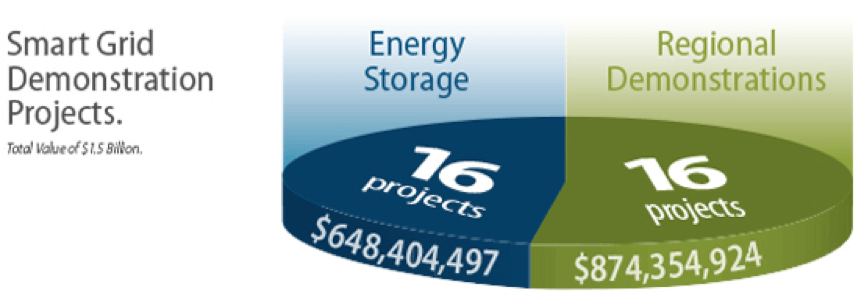The Smart Grid Demonstration Program (SGDP) is authorized by the Energy Independence and Security Act of 2007, Section 1304, as amended by the Recovery Act, to demonstrate how a suite of existing and emerging smart grid concepts can be innovatively applied and integrated to prove technical, operational, and business-model feasibility. The aim is to demonstrate new and more cost-effective smart grid technologies, tools, techniques, and system configurations that significantly improve on the ones commonly used today.
SGDP projects were selected through a merit-based solicitation in which the U.S. Department of Energy (DOE) provides financial assistance of up to 50% of the project's cost. Note that SGDP projects are cooperative agreements, whereas the Smart Grid Investment Grant projects are grants. Additional information about the original Funding Opportunity Announcement can be found in the SGDP Funding Opportunity Announcement (link is external).
Two types of smart grid projects were selected for the SGDP. One includes regional smart grid demonstrations to verify smart grid viability, quantify smart grid costs and benefits, and validate new smart grid business models at scales that can be readily replicated across the country. The second includes energy storage technologies such as batteries, flywheels, and compressed air energy storage systems for load shifting, ramping control, frequency regulation services, distributed applications, and the grid integration of renewable resources such as wind and solar power.
The program consists of 32 projects in the two areas: Smart Grid Regional Demonstrations (16 projects) and Energy Storage Demonstrations (16 projects). The total budget for the 32 projects is about $1.6 billion; the federal share is about $600 million.

Smart Grid Regional Demonstrations
Smart Grid Regional Demonstration projects are focused on advanced technologies for use in power system sensing, communications, analysis, and power flow controls. These projects are assessing the integration of advanced technologies with existing power systems including those involving renewable and distributed energy systems and demand response programs. The technical and economic performance of these technologies are being evaluated for applications such as microgrids, automated distribution systems, advanced metering infrastructure, and plug-in electric vehicles.
Energy Storage Demonstrations
Energy Storage Demonstrations are focused on grid-scale applications of energy storage involving a variety of technologies including advanced batteries, flywheels, and underground compressed air systems. These projects are demonstrating a variety of size ranges and system configurations and their impacts on the electric transmission and distribution grid. The technical and economic performance of these technologies is being evaluated for a variety of applications including load shifting, ramping control, frequency regulation services, voltage smoothing, distributed energy, and the grid integration of renewable resources such as wind and solar power.
Learn more about the Smart Grid Demonstration projects:
Projects
The location, information, and data for each smart grid project are provided in this section.Click for Projects
Publications
These reports include analysis, impacts, lessons learned, best practices, analytical tools, and case studies that were supported by the Recovery Act Smart Grid Programs.Click for Publications

